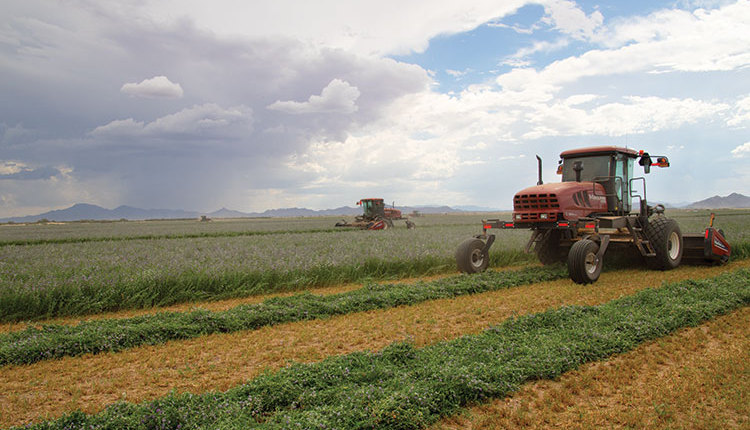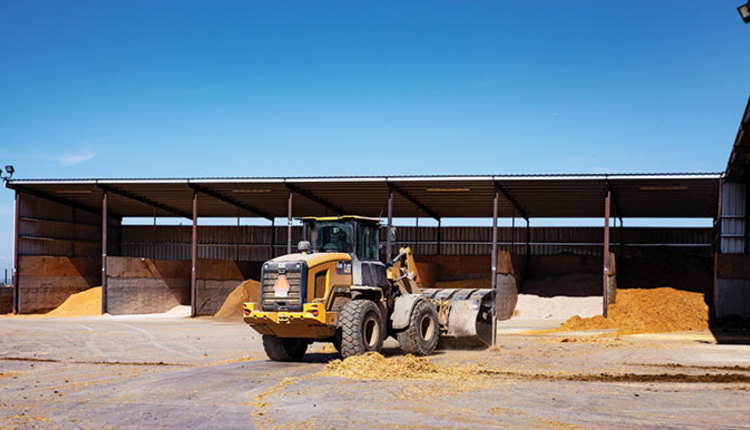The author is a trader with Cereal Byproducts Company, Port Washington, Wis.
This was the question posed to me a week ago by one of my customers as we considered an annual corn by-product feed purchase. He followed with the statement, "I guess I am greedy and want the bottom of the market." December corn had closed higher for the last five sessions in the face of extremely bearish news and was showing some technical strength. While this did not portend a huge rally back to last year's prices, it could indicate that the market was finding a harvest low.
Often in a buyer's mind, when large crops are projected, supplies can seem almost limitless, and prices can only go down further. The great majority of purchasers will ignore attractive prices, wait for a rebound off a bottom and then attempt to buy. However, it's always much easier to buy a good, long position value when the market has few buyers. Buyers then have the luxury of time and little competition; all the urgency is on the seller's side.
Fear and greed will drive every market, long or short, expensive or cheap. While it is not good to argue with a customer who harbors a strong opinion on the market, it is prudent for them to understand, and remember, that markets top out and bottom out when most people think they won't or can't. I would contend that the real purchase question for this dairyman was not, "Are we at the bottom of the market?" but rather, "Is this price a good value for me?"
The "protein predicament"
Earlier this year, we discussed the strong likelihood of a very tight carry out on old crop soybeans and the potential risk of shortages prior to the new crop. As of the middle of August, we have indeed seen both outages and shortages, as the basis for both have skyrocketed.
Soybean crushers have been offering up to $4 per bushel over the September CME value in an attempt to attract beans to crush. Soybean meal has become very difficult to source, with plants shutting down due to the lack of available beans. Meal prices have rocketed in the Upper Midwest to $220-plus per ton over the September CME price. Normally, this would only be about $30 to $40 over the respective CME month.
Little relief is expected until the middle of September, and then it will take some time to refill the supply pipeline. This is creating havoc and uncertainty in broader markets, as soybean meal is used as a reference standard and pricing point for other protein meals and feed by-products.
It is also cannibalizing other protein meals such as canola meal, which has continued to suffer supply issues due to the perpetual lack of rail capacity. Canola has continued to sell at $95 to $100 FOB under the CME soybean meal price each respective month as of late August. Meanwhile, it has lent support to distillers grains and gluten feed, which have both struggled recently.
Cottonseed comes back
Old crop cottonseed was a wild ride in both directions throughout August. Old crop dropped $100 per ton, then went up $70, then dropped $25, then went up $10, all in one week with a volume of less than five to eight truckloads on each price move in a thinly traded market. Mid-South harvest this fall will be very late, due to late planting, and is not likely to begin until the middle of October.
The Mid-South crop is estimated to be only 5 to 8 percent larger than last year. But, at new crop prices of $300 per ton or less delivered to Eastern Wisconsin, the Upper Midwest, Northwest and Idaho, these markets will likely easily absorb the seed the Western market won't take out of the Mid-South this year. Most Upper Midwest users had either scaled back or quit feeding seed when prices soared to over $500 per ton this spring and summer.
The Texas crop is very large, as their dryland cotton received ample rains. It is showing excellent quality and will largely service the Western dairies, taking demand off the Mid-South. The Southeast with a similar crop to last year will supply strong export demands as Australia's crop is off about 8 percent. Most major position traders don't believe the Eastern Wisconsin delivered market can go too much lower than the $290s delivered this fall.
Cottonseed will work well in these diets with poor performing first-crop alfalfa which is low in sugar and energy, and is causing poor dry matter intakes and performance, due to the late, wet spring. The other approaching issue is the highly variable, poor-quality, lower yielding new crop corn grain and silage in some dairy regions. Silage yields will be off by 20 to 30 percent and dangerously subject to the risk of an early frost. Many Wisconsin dairy processors have already complained about receiving lower milk flows this year, and it is unlikely to improve much with the coming corn crop.
Distillers downward spiral
The distillers grains market absolutely "fell out of bed" this summer as China exited the market due to supposed GMO issues with some U.S. corn. As a result, dry distillers grains prices dropped $10 to $15 per week, week after week, as ethanol producers attempted to find replacement markets.
Areas with good freight lanes, strong marketing, good quality and large cattle populations nearby bottomed out at $90 to $100 per ton FOB at the plants for dried grains. Locations not having these advantages saw very distressed levels of $50 per ton or less, as their production of spent grains struggled to find any markets.
The question on Chinese imports of U.S. distillers was not if they might return, but rather how, when, and at what levels and price points. It is already apparent that some of the Chinese market is returning, it is just not completely transparent as of yet. This was simply too large a market to just disappear, but it will reset at a different level and price.
This realization along with the recent tightness in the soybean market had already allowed prices to recover by $20 to $30 per ton at the end of August. Wet distillers also sold at rock-bottom levels this summer to nearby cattle producers, often being delivered for $20 to $40 per ton or less. The fall and early winter dried grains' markets looks to be priced at $110 to $120 per ton FOB at the plants as of late August.
Corn gluten priced well
Corn wet millers like to build sales positions for a new crop year early, so they are not forced into periodic "fire sales" to clear building inventories. Their early marketing for this coming new crop year was a challenge. Buyers were not coming to the gluten market, afraid of buying gluten feed at too great a price because of all the ongoing weakness in the corn market.
Wet millers were also concerned they could lose some of their gluten markets to cheap, distressed distillers grains. This was particularly a concern if the Chinese did not step back into the distillers market soon enough to stop their continued free fall in prices. These factors forced corn wet millers' hands on making aggressive gluten price drops and making some full year sales. This was done so they would be sure to maintain their markets, even though wet millers feel that these large yearlong clock sales' contracts have hurt them.
History suggests that clock sales have usually worked very well for dairymen. The challenge for gluten buyers this year was not recognizing the value in this aggressive gluten marketing soon enough. This reduction not only caught up to the price drops in the corn market, but had actually exceeded the drops of the corn market. Alert customer purchases, along with the corn market finding some basic, near-term support levels, and the tightness of the soybean market reversed the falling gluten feed market. Prices delivered into the Eastern Wisconsin market for new crop had sold as low as $118 to $125 per ton delivered to dairies and have since advanced $15 per ton.
Modified wet corn gluten feed sold as low as $50 to $60 per ton, depending on location and freight. Wet has since advanced about $5 to $7 per ton. At these prices, in a feed value spread sheet comparison, wet gluten was selling at a 46 percent discount to $3.75 dry rolled corn per bushel and $375 per ton to soybean meal. Customers need to remember that prices do not move in lock step with each other and what these value relationships mean for their individual operations.
This article appears on page 617 of the September 25, 2014 issue of Hoard's Dairyman.
This was the question posed to me a week ago by one of my customers as we considered an annual corn by-product feed purchase. He followed with the statement, "I guess I am greedy and want the bottom of the market." December corn had closed higher for the last five sessions in the face of extremely bearish news and was showing some technical strength. While this did not portend a huge rally back to last year's prices, it could indicate that the market was finding a harvest low.
Often in a buyer's mind, when large crops are projected, supplies can seem almost limitless, and prices can only go down further. The great majority of purchasers will ignore attractive prices, wait for a rebound off a bottom and then attempt to buy. However, it's always much easier to buy a good, long position value when the market has few buyers. Buyers then have the luxury of time and little competition; all the urgency is on the seller's side.
Fear and greed will drive every market, long or short, expensive or cheap. While it is not good to argue with a customer who harbors a strong opinion on the market, it is prudent for them to understand, and remember, that markets top out and bottom out when most people think they won't or can't. I would contend that the real purchase question for this dairyman was not, "Are we at the bottom of the market?" but rather, "Is this price a good value for me?"
The "protein predicament"
Earlier this year, we discussed the strong likelihood of a very tight carry out on old crop soybeans and the potential risk of shortages prior to the new crop. As of the middle of August, we have indeed seen both outages and shortages, as the basis for both have skyrocketed.
Soybean crushers have been offering up to $4 per bushel over the September CME value in an attempt to attract beans to crush. Soybean meal has become very difficult to source, with plants shutting down due to the lack of available beans. Meal prices have rocketed in the Upper Midwest to $220-plus per ton over the September CME price. Normally, this would only be about $30 to $40 over the respective CME month.
Little relief is expected until the middle of September, and then it will take some time to refill the supply pipeline. This is creating havoc and uncertainty in broader markets, as soybean meal is used as a reference standard and pricing point for other protein meals and feed by-products.
It is also cannibalizing other protein meals such as canola meal, which has continued to suffer supply issues due to the perpetual lack of rail capacity. Canola has continued to sell at $95 to $100 FOB under the CME soybean meal price each respective month as of late August. Meanwhile, it has lent support to distillers grains and gluten feed, which have both struggled recently.
Cottonseed comes back
Old crop cottonseed was a wild ride in both directions throughout August. Old crop dropped $100 per ton, then went up $70, then dropped $25, then went up $10, all in one week with a volume of less than five to eight truckloads on each price move in a thinly traded market. Mid-South harvest this fall will be very late, due to late planting, and is not likely to begin until the middle of October.
The Mid-South crop is estimated to be only 5 to 8 percent larger than last year. But, at new crop prices of $300 per ton or less delivered to Eastern Wisconsin, the Upper Midwest, Northwest and Idaho, these markets will likely easily absorb the seed the Western market won't take out of the Mid-South this year. Most Upper Midwest users had either scaled back or quit feeding seed when prices soared to over $500 per ton this spring and summer.
The Texas crop is very large, as their dryland cotton received ample rains. It is showing excellent quality and will largely service the Western dairies, taking demand off the Mid-South. The Southeast with a similar crop to last year will supply strong export demands as Australia's crop is off about 8 percent. Most major position traders don't believe the Eastern Wisconsin delivered market can go too much lower than the $290s delivered this fall.
Cottonseed will work well in these diets with poor performing first-crop alfalfa which is low in sugar and energy, and is causing poor dry matter intakes and performance, due to the late, wet spring. The other approaching issue is the highly variable, poor-quality, lower yielding new crop corn grain and silage in some dairy regions. Silage yields will be off by 20 to 30 percent and dangerously subject to the risk of an early frost. Many Wisconsin dairy processors have already complained about receiving lower milk flows this year, and it is unlikely to improve much with the coming corn crop.
Distillers downward spiral
The distillers grains market absolutely "fell out of bed" this summer as China exited the market due to supposed GMO issues with some U.S. corn. As a result, dry distillers grains prices dropped $10 to $15 per week, week after week, as ethanol producers attempted to find replacement markets.
Areas with good freight lanes, strong marketing, good quality and large cattle populations nearby bottomed out at $90 to $100 per ton FOB at the plants for dried grains. Locations not having these advantages saw very distressed levels of $50 per ton or less, as their production of spent grains struggled to find any markets.
The question on Chinese imports of U.S. distillers was not if they might return, but rather how, when, and at what levels and price points. It is already apparent that some of the Chinese market is returning, it is just not completely transparent as of yet. This was simply too large a market to just disappear, but it will reset at a different level and price.
This realization along with the recent tightness in the soybean market had already allowed prices to recover by $20 to $30 per ton at the end of August. Wet distillers also sold at rock-bottom levels this summer to nearby cattle producers, often being delivered for $20 to $40 per ton or less. The fall and early winter dried grains' markets looks to be priced at $110 to $120 per ton FOB at the plants as of late August.
Corn gluten priced well
Corn wet millers like to build sales positions for a new crop year early, so they are not forced into periodic "fire sales" to clear building inventories. Their early marketing for this coming new crop year was a challenge. Buyers were not coming to the gluten market, afraid of buying gluten feed at too great a price because of all the ongoing weakness in the corn market.
Wet millers were also concerned they could lose some of their gluten markets to cheap, distressed distillers grains. This was particularly a concern if the Chinese did not step back into the distillers market soon enough to stop their continued free fall in prices. These factors forced corn wet millers' hands on making aggressive gluten price drops and making some full year sales. This was done so they would be sure to maintain their markets, even though wet millers feel that these large yearlong clock sales' contracts have hurt them.
History suggests that clock sales have usually worked very well for dairymen. The challenge for gluten buyers this year was not recognizing the value in this aggressive gluten marketing soon enough. This reduction not only caught up to the price drops in the corn market, but had actually exceeded the drops of the corn market. Alert customer purchases, along with the corn market finding some basic, near-term support levels, and the tightness of the soybean market reversed the falling gluten feed market. Prices delivered into the Eastern Wisconsin market for new crop had sold as low as $118 to $125 per ton delivered to dairies and have since advanced $15 per ton.
Modified wet corn gluten feed sold as low as $50 to $60 per ton, depending on location and freight. Wet has since advanced about $5 to $7 per ton. At these prices, in a feed value spread sheet comparison, wet gluten was selling at a 46 percent discount to $3.75 dry rolled corn per bushel and $375 per ton to soybean meal. Customers need to remember that prices do not move in lock step with each other and what these value relationships mean for their individual operations.











